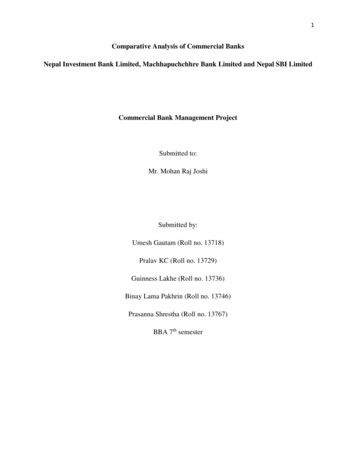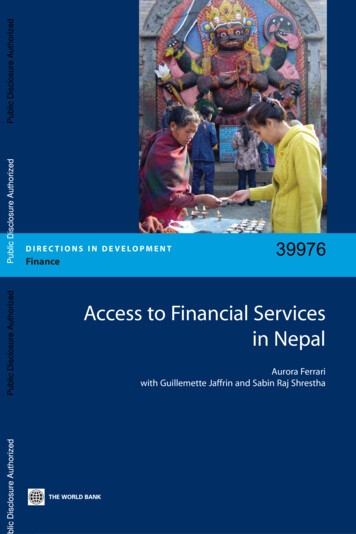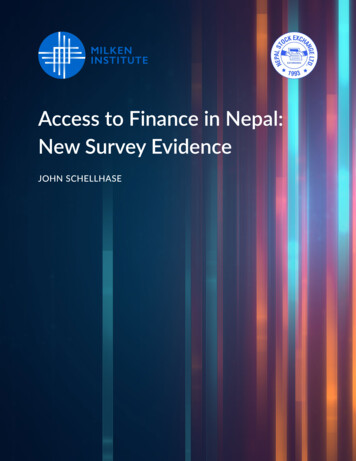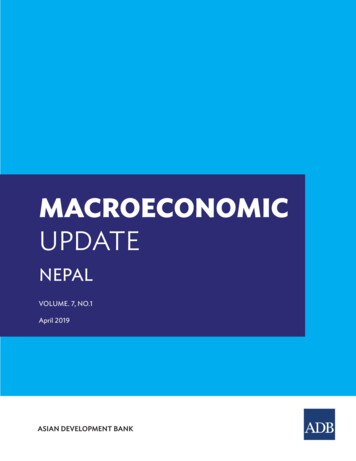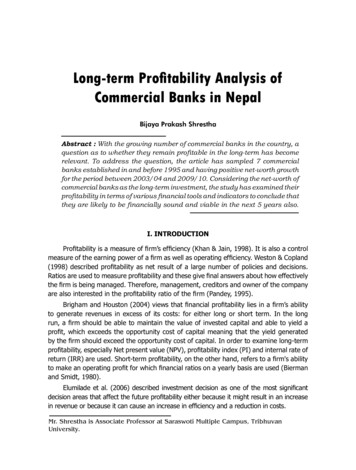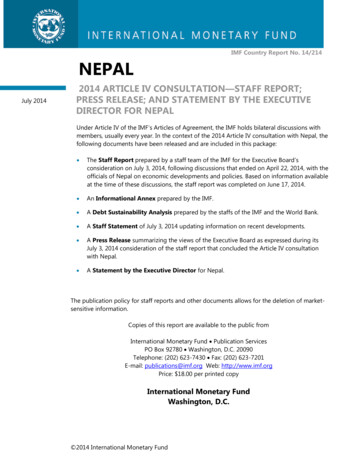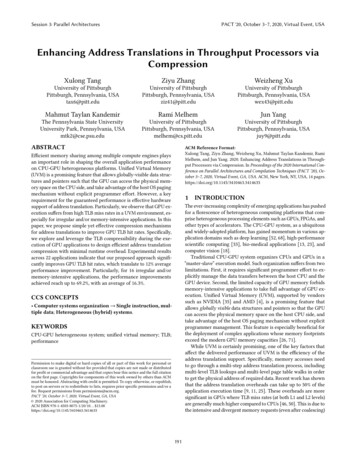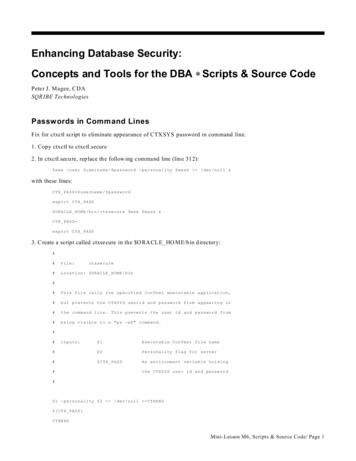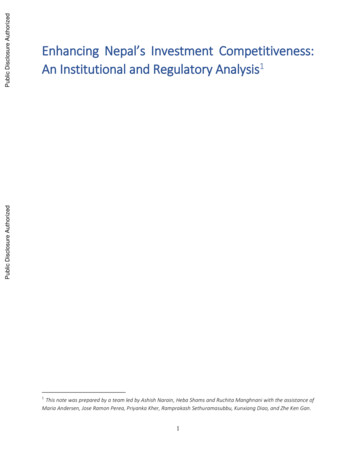
Transcription
Public Disclosure AuthorizedPublic Disclosure AuthorizedPublic Disclosure AuthorizedPublic Disclosure AuthorizedEnhancing Nepal’s Investment Competitiveness:An Institutional and Regulatory Analysis11This note was prepared by a team led by Ashish Narain, Heba Shams and Ruchita Manghnani with the assistance ofMaria Andersen, Jose Ramon Perea, Priyanka Kher, Ramprakash Sethuramasubbu, Kunxiang Diao, and Zhe Ken Gan.1
Executive SummaryNepal needs much stronger growth if it is to attain the government’s objective of achieving middleincome status by 2030. Over the past decade, Nepal has achieved an average growth rate of a little over4 percent. This was largely driven by strong remittance flows that contributed more than one-quarter ofgross domestic product (GDP). However, this remittance-driven model cannot deliver the high levels ofgrowth needed to achieve the government’s ambitious development targets. Stronger trade andinvestment performance and greater integration in the global economy are also needed.Nepal’s foreign direct investment (FDI) inflows are low and volatile, and show high levels ofconcentration in terms of source and sectors. FDI inflows have plateaued at less than 0.5 percent ofGDPError! Reference source not found. FDI inflows as a share of GDP are substantially lower in Nepalthan other countries in South Asia, such as Bangladesh, India and Sri Lanka, as well as countries inSoutheast Asia, such as Lao PDR and Cambodia. Nepal also depends on a more limited range of sourcecountries for its FDI. Nepal’s FDI has also become concentrated in fewer sectors in recent years, with themajority of investment targeting the supply of the domestic market (market-seeking investment).Improving the institutional performance and the overall investment climate are key in attracting FDIand strengthening Nepal’s competitiveness. This is supported by the findings of the World EconomicForum’s (WEF) Global Competitiveness Index (2017-18), in which Nepal ranks 88 for 2017-18, animprovement of 10 spots compared with 2016-17. In terms of regional ranking, Nepal was fourth afterIndia (40), Bhutan (82) and Sri Lanka (85). Technological readiness, efficiency in the labor market, andhigher education and training remain areas of concern. A weak enabling environment discouragesentrepreneurship and investor confidence in the overall business climate. Nepal ranks 110 in the WorldBank’s Doing Business 2019 report. There is substantial scope for improvement along several dimensions,including paying taxes, contract enforcement, dealing with construction permits, and the ease of gettingelectricity and starting a business.This policy note aims to provide an overview of Nepal’s current and potential position in attractingforeign investment. The note suggests short- and medium-term reform actions. It begins by assessingrecent trends in FDI and proceeds to evaluate the institutional framework for investment policy andpromotion, and the legal and regulatory framework that governs FDI in Nepal, based on which policyrecommendations are made.The institutional framework for foreign investment in Nepal is complex, with multiple institutionsinvolved in investment policymaking and their implementation. These include the Department ofIndustry (DoI), Investment Board of Nepal (IBN), the central bank Nepal Rastra Bank (NRB), and theIndustrial and Investment Promotion Board (IIPB). Some of the responsible agencies have overlappingmandates. Furthermore, with federalism under the new Constitution, it is not clear how the licensing,permits and inspection processes will be affected by the multiple layers of government.Foreign investment in Nepal is also governed by a number of laws and regulations that overlap in certainrespects. These include: (i) the Foreign Investment and Technology Transfer Act 1992 (2048) (FITTA); (ii)the Foreign Exchange (Regulation) Act 1962 (2019); (iii) the Investment Board Act 2011 (2068); and (iv)the Foreign Investment and One Window Policy of 2015, the Non-Resident Nepali Act (2008) and NonResident Nepali Rules (2010). There are several new acts in the pipeline, such as the Foreign InvestmentAct and the PPP-IBN Act, which will impact the regulatory framework on FDI once they are implemented.2
Currently, prior approval is required by foreign investors before investing in Nepal. Nepal has an ex-antescreening process that requires foreign investors to obtain prior approval before investing. The approvalprocess for foreign investment in Nepal is often discretionary and delayed. The legal framework for FDI inNepal imposes a minimum investment requirement, which is not considered good practice. The currentlegal framework also imposes a foreign equity cap in many sectors. Entry of foreign investment into Nepalis subject to both a negative and a positive list.The current framework for foreign investment in Nepal, the Foreign Investment and TechnologyTransfer Act (FITTA), does not provide the core protection guarantees of non-discrimination. Contraryto good international practice, FITTA does not contain the core principles of national treatment and mostfavored-nation (MFN) status. This lack of protection under domestic law may also result in a breach ofNepal’s bilateral investment agreements and free-trade commitments, where such non-discriminationguarantees are agreed upon.The scope of protection against expropriation is narrow. While there are different legal instruments thatprotect investors against direct expropriation, the scope of protection against expropriation is narrow(i.e., nationalization) and does not extend to indirect expropriation, which can have a similar impact asdirect expropriation. Also, the protection against expropriation does not provide the guarantee of dueprocess.The scope of investors’ repatriation rights in Nepal falls short of international standards. Repatriationrights do not explicitly guarantee repatriation of payments obtained as compensation from expropriation,or any indemnity or compensation received as a result of final resolution of a dispute. The law does notrequire prior approval for the repatriation of foreign investment. However, in practice, it is subject to dualapprovals by NRB and the DoI, with no prescribed time period within which these approvals can beobtained. FDI divestment and repatriation are further restricted by a one-year lock-in period. There arealso restrictions on the repatriation of service fees and the income earned by foreign nationals.The existing legal framework does not provide a dispute settlement mechanism between foreigninvestors and the State. The measures for the settlement of disputes prescribed in FITTA are concernedonly with disputes between the foreign investor, the national investor and the industry. As Nepal is partyto several international investment agreements (IIAs), it is important for the Government of Nepal (GoN)to ascertain the gap that exists between Nepal’s commitments in its IIAs and its domestic legal frameworkon investment; and to determine to what extent the de jure IIA commitments are actually implementedin practice.There are several constraints related to transactions for foreign investment in the existing regulatoryframework. Foreign lenders are subordinated to local banks in priority of repayment and this creates adisincentive to foreign lenders. The current interest rate cap on foreign currency loans (12-month US LIBOR 550 bps, including the hedging cost) is unattractive to foreign lenders. The creation of a mortgageof land in favor of foreign lenders requires cabinet approval and the enforcement of security requires acourt order, making the process lengthy.This policy note makes several recommendations for reforms in the current regulatory and institutionalframework governing FDI. The reform recommendations summarized below include: (i) having a coherentstrategy for attracting and retaining investment; (ii) rationalization of the institutional structure governingFDI; (iii) implementing a modern investment law that adheres to international best practice on approval3
of FDI, investor protection, repatriation, dispute resolution, etc.; and (iv) the easing of transaction-specificconstraints to foreign investment.There is need to articulate a clear investment policy statement through a comprehensive process ofstakeholder consultation. The investment strategy could target foreigners, non-resident Nepalis, as wellas domestic investors and address how constraints to investment will be dealt with.It is recommended that the mandate and resources for investment promotion be given to a singleagency. This agency should then develop an action plan for investment promotion, implement the overallinvestment strategy of the GoN, and provide investment aftercare services.The FITTA needs to be replaced with a modern investment law aligned to international commitmentsand internationally recognized best practice. This revised law should eliminate ex-ante screening andapproval mechanisms and discriminatory treatment to FDI, reduce red tape and bureaucracy affectingentry/establishment of investment in the country, streamline the business establishment processes, andimplement the “one-window system” policies as enshrined in the “Foreign investment and one-windowpolicy” of 2015. The new investment law should allow for automatic approval of FDI in general and abolishthe “minimum investment requirements” to encourage the free flow of investment into the country.The legal framework requires a full set of investor rights and investor protection, and the repatriationprocess needs to be reformed. A standard range of investor rights, including asset protection andenforcement rights consistent with the country’s IIAs need to be incorporated. The time involved inrepatriation, as well as the number of procedures in the repatriation process, should be reduced.Additional approval requirements in the repatriation processes can be eliminated. Discretionary practicesfor repatriation of proceeds/fees from technology transfer arrangements, as well as the DoI approvalrequirements for repatriation of fees concerning management agreements, need to be reformed.An updated foreign investment act should adhere to internationally recognized best practice on adispute resolution framework. It should provide for a dispute settlement mechanism between foreigninvestors and the State, and include a dispute resolution mechanism through arbitration, preferablyinternational arbitration. The involvement of the DoI in the mediation process for disputes involvingforeign investments should be eliminated. There should be an effective grievance managementmechanism to resolve issues faced by investors early on to prevent them from escalating into fully-fledgeddisputes.Transaction-specific constraints to foreign investment need to be eased. Foreign lenders should begranted pari-passu treatment with local lenders in terms of the priority of repayment. Currently, they aresubordinated to local banks. The rationale behind an interest rate cap on foreign currency loans shouldbe revised and hedging cost should be separated from the total interest rate cap. The procedure for thecreation of mortgages of land in favor of foreign lenders needs to be made easier.The government has some ongoing initiatives that seek to address the shortcomings of the currentregulatory framework and improve the conditions for FDI in Nepal. There is a Foreign Investment andTechnology Act draft bill under discussion within the government. NRB proposes to issue directives toenhance foreign lenders’ rights by facilitating the perfection and enforcement of collateral through localagent banks and increase financing sources through higher limits on foreign currency borrowings. Thesereforms, once implemented, are expected to improve the climate for FDI in Nepal.4
I. IntroductionNepal has been one of the slowest growing economies of South Asia, with growth averaging just over 4percent a year. The present remittance-driven model is unable to deliver sustainable growth in GDP oremployment. The lack of adequate jobs has led to more than one-quarter of the labor force workingoverseas. Their remittances, more than one-quarter of GDP, are believed to have underpinned a dramatic28-percentage-point reduction in poverty between 2003 and 2011. However, this has also led to anappreciation of the real exchange rate, which has hurt exports and resulted in rising imports. Without asignificant rebalancing of the economy toward a more investment-led model, growth is unlikely to exceed5 percent. The current growth rate is insufficient for the country to meet the government’s objective ofachieving lower middle-income status by 2030.Trade and investment can be important drivers of growth, but performance has been lackluster. Nepal’sexports and imports are lower, on average, than other countries at similar income levels, even afteraccounting for its size, remoteness from main markets, and its landlocked status. The situation hasworsened relative to the 1990s. The trade-to-GDP ratio has declined from an average of 59 percentbetween 1995 and 1999, to 46 percent between 2010 and 2014. Merchandise export growth has almostflat-lined. Exports are concentrated in a narrow range of agricultural and low value-added manufacturedproducts, in globally declining market segments. Moreover, Nepal exports only to a handful of countries.Services exports have performed better, growing on average by 17 percent annually since 2005 andreaching US 1.2 billion (54 percent of Nepal’s total exports) in 2014. However, exports of services are alsoconcentrated in just a few industries.Achieving greater integration in the global economy and building a competitive export sector willrequire addressing several economic and institutional challenges. To aid this process, the Governmentof Nepal (GoN) has devoted substantial resources to promoting trade, foreign direct investment (FDI), andtourism. As pa
process for foreign investment in Nepal is often discretionary and delayed. The legal framework for FDI in Nepal imposes a minimum investment requirement, which is not considered good practice. The current legal framework also imposes a foreign equity cap in many sectors. Entry of foreign investment into Nepal
